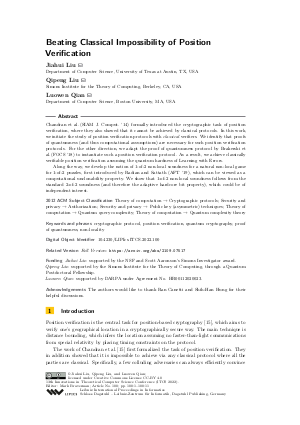@InProceedings{liu_et_al:LIPIcs.ITCS.2022.100,
author = {Liu, Jiahui and Liu, Qipeng and Qian, Luowen},
title = {{Beating Classical Impossibility of Position Verification}},
booktitle = {13th Innovations in Theoretical Computer Science Conference (ITCS 2022)},
pages = {100:1--100:11},
series = {Leibniz International Proceedings in Informatics (LIPIcs)},
ISBN = {978-3-95977-217-4},
ISSN = {1868-8969},
year = {2022},
volume = {215},
editor = {Braverman, Mark},
publisher = {Schloss Dagstuhl -- Leibniz-Zentrum f{\"u}r Informatik},
address = {Dagstuhl, Germany},
URL = {https://drops-dev.dagstuhl.de/entities/document/10.4230/LIPIcs.ITCS.2022.100},
URN = {urn:nbn:de:0030-drops-156963},
doi = {10.4230/LIPIcs.ITCS.2022.100},
annote = {Keywords: cryptographic protocol, position verification, quantum cryptography, proof of quantumness, non-locality}
}

 Creative Commons Attribution 4.0 International license
Creative Commons Attribution 4.0 International license

